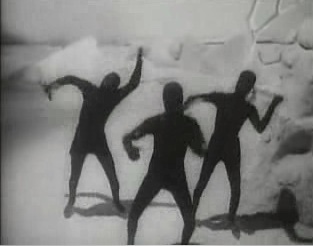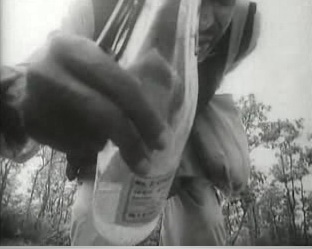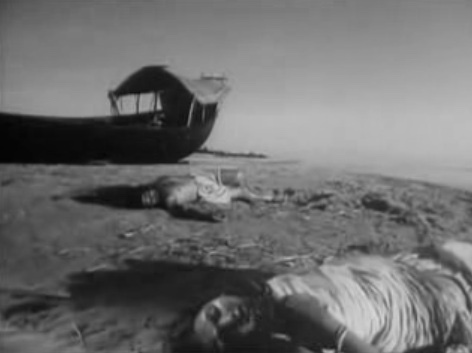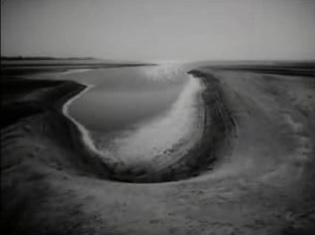
The title characters, seemingly scribbled carelessly on a dirty piece of cloth, are projected one after another as if time is precious, and in the background, free percussion and drums intermingle violently while the atonal flute is played. Then, a frontal image of an old man sitting on the ground half-naked and staring blankly at a point in a hut is followed by a sudden appearance of a group of three people in all-black costumes dancing an unusual dance to sitar and percussion on a completely white set. Is this a response from India to Atsushi Yamatoya's Inflatable Sex Doll of the Wastelands (1967)? Ritwik Ghatak's final feature film, Jukti Takko Aar Gappo/Reason, Debate and a Story(1974), which depicts the wanderings of an alcoholic man, is a masterpiece that reveals that he was a great brother of Cassavetes, Monteiro, and Peckinpah (the final scene is a Brechtian gunfight!) The film is a self-portrait of the end of an intellectual's life against the backdrop of the partition of Bengal and the failure of the political movement in the immediate post-WWII period, and it is a “burial before death” for Ghatak himself (in this respect, it is ahead of Monteiro's Come and Go). After being thrown out of his house by his wife and son, he sets off on a wandering journey through the countryside with a young unemployed man who was once one of his students and a Bangladeshi girl. There, he meets a Sanskrit teacher, a former intellectual who is now a pornographic novelist, and an anti-government guerrilla, and engages in dialogue with them.

As in Reason, Debate and a Story, which also features a wealth of footage of life and festivals in various regions, Ghatak mixes documentary with fictional frameworks. Already in 1961, Komal Gandhar/E-Flat was worthy of being a contemporary of Jacques Rivette, with a joint performance by two opposing theater companies unfolding alongside melodrama (perhaps a double feature of this film and Paris nous appartient is necessary... but this one hasn't been released in Japan either!) While still remaining within the framework of classical cinema, the film depicts a re-enactment of the leftist theater movement of the 1940s by the IPTA (Indian People's Theater Association), of which Ghatak himself was a member, and also unexpectedly incorporates outdoor scenery and the wildness of nature, like a heavy rain pouring down on the window of a couple in love. Ghatak's most moving film, The River Called Titash (1971), made in Bangladesh, depicts the history of a village on the banks of the Titash River, focusing on the tragedy of a fisherman who goes mad after his wife is temporarily kidnapped and a woman who falls in love with him and takes his son in, while also inserting a documentary of the river's own rich expression as it changes from the dry to the rainy season. The film repeatedly captivates the viewer with its superb cinematography, which carries on the sensual, slow rhythm depicted by Renoir in The River, but also contains a different kind of deviation and ferocity from Satyajit Ray's work.

Even when the film is a conversation between two characters, Ghatak often uses a wide-angle lens to capture the full depth of the space in the composition of the screen, and he often connects the screen with a reverse composition of the whole view rather than a close-up of the characters' eyes (from the point of emphasis on space, it is also possible to compare it to Mizoguchi's films which Ghatak respected). For this reason, the background of the head of the woman alone is often a long shot, but this is probably because the movement of unexpected people, nature and miscellaneous objects is likely to enter the frame, and it would be dangerous to try to create a perfect shot. In fact, it can be said that Ritwik Ghatak was a filmmaker who was conscious of the “outside” and had his sights set on modern cinema, to the extent that he was willing to have people in the background approach the camera or send it glances (perhaps for this reason, he was isolated and met an untimely death). And when he uses close-ups, for example in the scene where the women who love the mad husband but know he will never return to sanity gather around the fire and talk in tones of sadness and realization, it is dazzlingly moving in itself.
As I mentioned at the beginning, the madness is also expressed in the unusual use of sound along with the images on the screen. As has already been mentioned in many English-language sources, perhaps because it is easy to accept as a straightforward “woman's life story”, in the previously introduced Meghe Dhaka Tara/The Cloud-Capped Star when the heroine, who has been hospitalized near the end of the story, exclaims “I want to live!”, her voice suddenly echoes across the mountains with an echo, and in the background you can hear an unusual sound that is neither a bomb blast nor the sound of waves. In E-Flat, when the heroine returns home late at night after deciding to break up with her boyfriend, the director, and go to Paris, the sound of a child calling, gunshots and the tinkling of bells follow her in a loop. In The River Called Titash, the rough breathing of the bride can be heard in the background as the lovers prepare to spend their first night together. Of course, like in Noboru Tanaka's Hitozuma Shudan Boko Chishi Jiken/Rape And Death Of A Housewife(1978), the images fade out without depicting the sex itself, but that is also a premonition of the woman's death. Also, when the son calls out his mother's name, anticipating her death, the piercing high-pitched sound of a flute pierces the air, and when the woman who takes the son in reveals her anger at him, who will never warm to her, like a demon, the sound of the beating of the laundry on the riverbank rings out abnormally loud. And when the woman, who has been driven from her land and has lost everything, wanders through the desert, she sees the vision of her son, who has also left, running through the fields like a madman, blowing a strange-sounding trumpet...

The reason I'm writing about a Ghatak film that you can already watch on DVD, or even on the web (but without subtitles), is because I want to see it in a cinema, which is naturally the best place to watch it. I know that there is no point in writing this, as there is no chance of anyone involved in the film industry reading this site and responding to it these days... But with the Indian film boom long gone, the TSUTAYA section no longer exists, and the Asian boom has also passed (it seems that Japanese films are currently in vogue, but if this trend disappears, will movie theaters themselves disappear too?), now is the time to take the time to fully appreciate the madness that pervades the films of Ghatak. And in this context, it would be interesting to look for his successors who are aware of the “outside”... beyond the Bengali-speaking world, in India (even though there are a huge number of films, there is no country in the world that is as confined to a narrow category as this multilingual country, so it doesn't have to be an officially recognized disciple like Mani Kaul (his Ashad ka ek din /A Monsoon Day is the best Indian theater=cinema film) or Adoor Gopalakrishnan, or even in Hollywood, where immigrants from the Tamil-speaking world like M. Night Shyamalan have found their niche (it's not a wild guess, in terms of the story of a family community in relation to the outside world)?

*After writing this text, I heard that The River Called Titas and “Reason, Debate and a Story will be screened at TOKYO FILMeX 2007. The other two films are The Unmechanical (previously introduced as Ajantrik) and Golden Line. It's a shame that his debut work, Nagarik/The Citizen, which seems to have been influenced by The magnificent Ambersons and Rocco i suoi fratelli, is not included...
(August 8, 2007)
©Akasaka Daisuke